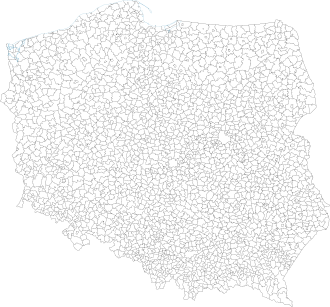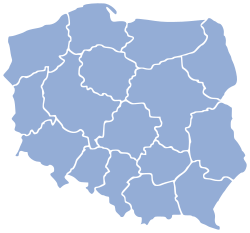Gmina
The gmina (Polish pronunciation [ˈɡmina], plural gminy [ˈɡminɨ], from German Gemeinde meaning commune) is the principal unit of the administrative division of Poland, similar to a municipality. As of January 1, 2019, there were 2477 communes throughout the country, encompassing 940 cities and over 43,000 villages.[1]

 Contour map of Poland indicating modern voivodeships |
| Administrative divisions of Poland |
|---|
|
Voivodeships Powiats (list) Gminas (list) |
The gmina has been the basic unit of territorial division in Poland since 1974, when it replaced the smaller gromada (cluster). There are three types of gminy:
- 302 urban gmina (Polish: gmina miejska) consisting of just one city or town,
- 638 mixed urban-rural gmina (Polish: gmina miejsko-wiejska) consisting of a town and surrounding villages and countryside; and
- 1537 rural gmina (Polish: gmina wiejska) consisting only of villages and countryside (occasionally of just one village).
Some rural gminy have their seat in a town which is outside the gmina's division. For example, the rural Gmina Augustów is administered from the town of Augustów, but does not include the town, as Augustów is an urban type gmina in its own right.
The legislative and controlling body of each gmina is the elected municipal council (rada gminy), or in a town: rada miasta (town assembly). Executive power is held by the directly elected mayor of the municipality, called wójt in rural gminy, burmistrz in most urban and urban-rural gminy, or prezydent in towns with more than 400,000 inhabitants and some others which traditionally use the title. A gmina may create auxiliary units (jednostki pomocnicze), which play a subordinate administrative role. In rural areas these are called sołectwa, in towns they may be dzielnice or osiedla and in an urban-rural gmina, the town itself may be designated as an auxiliary unit. The only gmina which is statutory obliged to have auxiliary units is Warsaw, which is divided since 2002 into 18 boroughs of a status similar to the urban gminas, although they are not considered as separate division units. For a complete listing of all the gminy in Poland, see List of Polish gminas.
Three or more gminas make up a higher level unit called powiat. Each and every powiat has the seat in a city or town, which can be an urban gmina or be a part of an urban-rural one. However, several urban gminas that are the major Polish cities and towns (including all voivodeship seats) have the special status of urban powiats (miasto na prawach powiatu, powiat grodzki), and as of 2020 there is 66 of them. Such town or city is a separate single-gmina powiat and even if it is the seat of a regular one, it does not belong to it administratively. In the urban powiats, the roles of the powiat organs are fulfilled by the ones of the urban gmina it is made of.
Types of administrative tasks and objectives
Each gmina carries out two types of tasks: its own tasks and commissioned ones. Own tasks are public tasks exercised by self-government, which serve to satisfy the needs of the community. The tasks can be twofold:
- compulsory – where the municipality cannot decline to carry out the tasks, and must set up a budget to carry them out in order to provide the inhabitants with the basic public benefits
- optional – where the municipality can carry them out in accordance with available budgetary means, set out only to specific local needs (on the gmina's own responsibility and budget).
Own objectives
Own high objectives include matters such as spatial harmony, real estate management, environmental protection and nature conservation, water management, country roads, public streets, bridges, squares and traffic systems, water supply systems and source, the sewage system, removal of urban waste, water treatment, maintenance of cleanliness and order, sanitary facilities, dumps and council waste, supply of electric and thermal energy and gas, public transport, health care, welfare, care homes, subsidised housing, public education, cultural facilities including public libraries and other cultural institutions, historic monuments conservation and protection, the sports facilities and tourism including recreational grounds and devices, marketplaces and covered markets, green spaces and public parks, communal graveyards, public order and safety, fire and flood protection with equipment maintenance and storage, maintaining objects and devices of the public utility and administrative buildings, pro-family policy including social support for pregnant women, medical and legal care, supporting and popularising the self-government initiatives and cooperation within the commune including with non-governmental organizations, interaction with regional communities from other countries, etc.
Commissioned tasks
Commissioned tasks cover the remaining public tasks resulting from legitimate needs of the state, commissioned by central government for the units of local government to implement. The tasks are handed over on the basis of statutory by-laws, charters and regulations, or by way of agreements between the self-government units and central-government administration.
Overall number of gminy by type
| Number of gminy by voivodeship | |||||||||||||||||
| Voivodeship | LS | KP | LBL | LBS | ŁD | LP | MS | OP | SK | PD | PM | SL | ŚWK | WM | GP | WP | Poland |
| Urban gminy | 36 | 17 | 20 | 9 | 18 | 15 | 35 | 3 | 16 | 13 | 25 | 49 | 5 | 16 | 19 | 11 | 307 |
| Urban-rural gminy | 55 | 35 | 22 | 33 | 25 | 43 | 50 | 32 | 31 | 24 | 17 | 22 | 26 | 33 | 90 | 52 | 588 |
| Rural gminy | 78 | 92 | 171 | 41 | 134 | 124 | 229 | 36 | 113 | 81 | 81 | 96 | 71 | 67 | 117 | 51 | 1,584 |
| Total gminy | 169 | 144 | 213 | 83 | 177 | 182 | 314 | 71 | 160 | 118 | 123 | 167 | 102 | 116 | 226 | 114 | 2,479 |
| of which: rural gminy with their seat outside the gmina | 14 | 13 | 17 | 5 | 15 | 9 | 15 | 0 | 12 | 12 | 13 | 0 | 1 | 15 | 11 | 8 | 160 |
Abbreviations used for voivodeships:
LS: Lower Silesian Voivodeship, KP: Kuyavian-Pomeranian Voivodeship, LBL: Lublin Voivodeship, LBS: Lubusz Voivodeship,
ŁD: Łódź Voivodeship, LP: Lesser Poland Voivodeship, MS: Masovian Voivodeship, OP: Opole Voivodeship,
SK: Subcarpathian Voivodeship, PD: Podlaskie Voivodeship, PM: Pomeranian Voivodeship, SL: Silesian Voivodeship,
ŚWK: Świętokrzyskie Voivodeship, WM: Warmian-Masurian Voivodeship, GP: Greater Poland Voivodeship, WP: West Pomeranian Voivodeship.
Largest and smallest gminy
| LARGEST | Population (2006 estimate) | Land area in km² | Population density per km² |
|---|---|---|---|
| Urban | Warsaw (1,697,596) | Warsaw (517.22) | Świętochłowice (4,156.80) |
| Rural | Gmina Chełmiec (24,344) | Gmina Wałcz (574.89) | Gmina Buczkowice (542.70) |
| Urban-rural | Gmina Piaseczno (61,525) | Gmina Pisz (633.69) | Gmina Wołomin (801.69) |
| Town in urban-rural gmina | Gmina Nysa: Nysa (47,545) | Gmina Szczytna: Szczytna (80.38) | Gmina Swarzędz: Swarzędz (3,469.23) |
| Rural part of urban-rural gmina | Gmina Wieliczka: rural part (28,864) | Gmina Pisz: rural part (623.61) | Gmina Świątniki Górne: rural part (407.86) |
| SMALLEST | Population (2006 estimate) | Land area in km² | Population density per km² |
| Urban | Krynica Morska (1,364) | Górowo Iławeckie (3.32) | Krynica Morska (11.74) |
| Rural | Gmina Cisna (1,663) | Gmina Jejkowice (7.59) | Gmina Lutowiska (4.63) |
| Urban-rural | Gmina Nowe Warpno (1,559) | Gmina Świątniki Górne (20.35) | Gmina Nowe Warpno (7.88) |
| Town in urban-rural gmina | Gmina Wyśmierzyce: Wyśmierzyce (892) | Gmina Stawiszyn: Stawiszyn (0.99) | Gmina Suraż: Suraż (28.94) |
| Rural part of urban-rural gmina | Gmina Nowe Warpno: rural part (363) | Gmina Suchedniów: rural part (15.54) | Gmina Nowe Warpno: rural part (2.09) |
References
- Official report from the Central Statistical Office of Poland dated January 1, 2006, (pages 49–151, in Polish)
External links
| Wikimedia Commons has media related to |